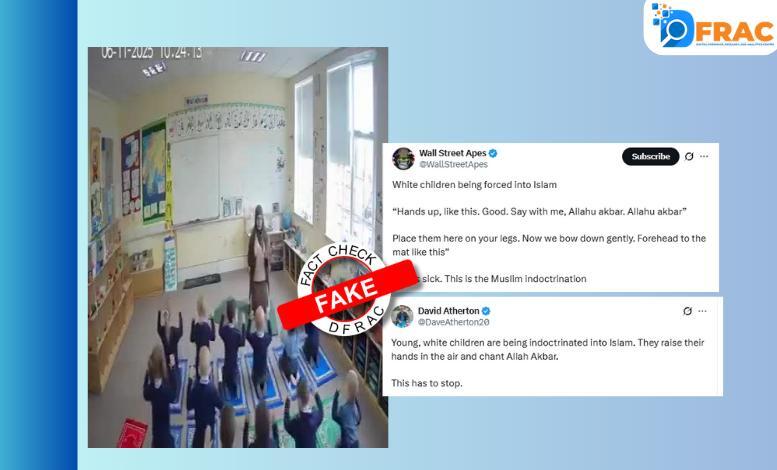
Viral classroom indoctrination video found to be fake
In recent days, a disturbing video has been circulating on social media platforms, alleging that school children in a British classroom were being “indoctrinated into Islam” and chanting “Allahu Akbar”. The video, which has sparked widespread outrage and concern among parents and educators, has been shared thousands of times, with many calling for an investigation into the alleged incident. However, a thorough fact-check by DFRAC has found the claim to be entirely fake.
The video, which appears to show a group of children standing in a classroom, chanting “Allahu Akbar” in unison, has been widely condemned as an example of “Islamic indoctrination” in British schools. However, a closer examination of the footage has revealed clear signs of digital manipulation. Upon reviewing the video, DFRAC’s fact-checkers noticed several anomalies that suggest the video is artificially generated.
One of the most striking examples of manipulation is the sudden appearance of an unexplained chair in the background of the video. At the beginning of the clip, the chair is not visible, but it suddenly materializes in the background, with no explanation as to how it got there. This is a clear indication that the video has been edited or manipulated in some way.
Another anomaly that caught the attention of DFRAC’s fact-checkers is the changing size of a child’s hair tie. In one frame, the hair tie appears to be a certain size, but in the next frame, it has suddenly grown or shrunk, depending on the perspective. This is a classic sign of digital manipulation, where the video has been edited to create a specific narrative or impression.
These findings have significant implications for the public’s understanding of the video and its claims. Rather than being a genuine example of “Islamic indoctrination” in a British classroom, the video appears to be a carefully crafted piece of propaganda, designed to stir up outrage and fear. It is a stark reminder of the dangers of misinformation and the importance of fact-checking in the digital age.
The spread of fake news and propaganda has become a major concern in recent years, with social media platforms playing a significant role in the dissemination of false information. The viral classroom indoctrination video is just one example of how misinformation can be used to manipulate public opinion and create fear and division.
In this case, the video has been used to perpetuate negative stereotypes and prejudices against Muslims and the Islamic faith. By presenting a fake scenario as real, the creators of the video have sought to create a sense of outrage and fear among the public, which can have serious consequences for community relations and social cohesion.
The fact that the video has been shared thousands of times, with many people believing it to be true, highlights the need for greater critical thinking and media literacy in the digital age. It is essential that people are equipped with the skills to evaluate information critically, to identify signs of manipulation and propaganda, and to seek out credible sources of information.
In conclusion, the viral classroom indoctrination video has been found to be fake, with clear signs of digital manipulation and propaganda. The video’s claims of “Islamic indoctrination” in a British classroom are entirely unfounded, and the footage has been edited to create a specific narrative or impression. It is essential that people are aware of the dangers of misinformation and the importance of fact-checking in the digital age.
As we move forward, it is crucial that we prioritize critical thinking and media literacy, and that we seek out credible sources of information to inform our opinions and decisions. By doing so, we can create a more informed and discerning public, who are less susceptible to the influences of misinformation and propaganda.
News Source: https://dfrac.org/en/2025/11/19/viral-classroom-video-claiming-islamic-indoctrination-found-to-be-fake/





